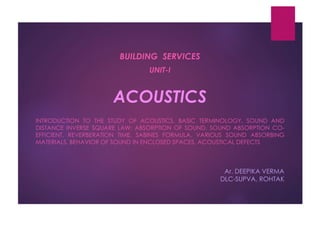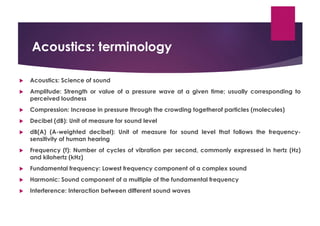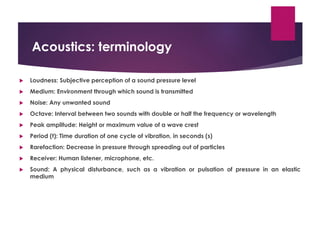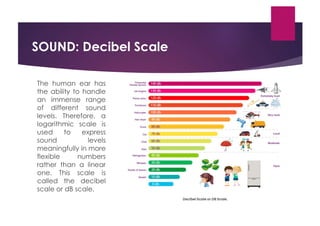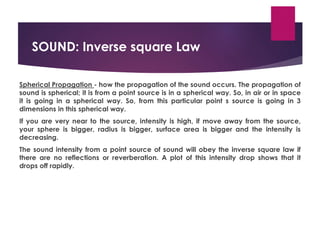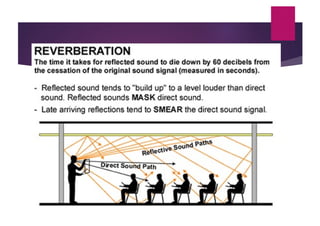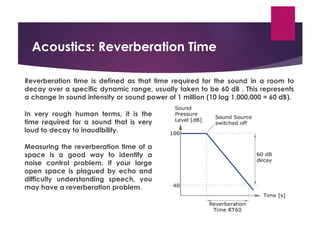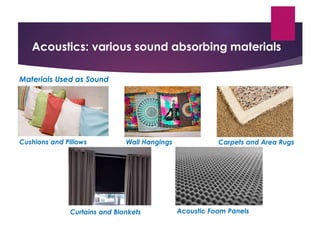ACOUSTICS.pdf
- 1. ACOUSTICS INTRODUCTION TO THE STUDY OF ACOUSTICS, BASIC TERMINOLOGY, SOUND AND DISTANCE INVERSE SQUARE LAW; ABSORPTION OF SOUND, SOUND ABSORPTION CO- EFFICIENT. REVERBERATION TIME, SABINES FORMULA, VARIOUS SOUND ABSORBING MATERIALS. BEHAVIOR OF SOUND IN ENCLOSED SPACES, ACOUSTICAL DEFECTS Ar. DEEPIKA VERMA DLC-SUPVA, ROHTAK BUILDING SERVICES UNIT-I
- 2. ACOUSTICS The branch of physics which deals with generation, reception, propagation and analysis of sound is called acoustics. The study of sound waves plays an important role in many engineering and non - engineering applications. The areas of acoustical studies and their applications include Architectural acoustics - Study of sound waves in closed halls and buildings. Musical acoustics - Physics of musical instruments Engineering acoustics - Technology of sound production and recording, study of vibrations of solids and their control as well as noise control. Bio-acoustics / Medical acoustics - Use of sound in medical diagnosis and therapy.
- 3. In architecture, acoustics is an essential element in the design of buildings and spaces that require good sound quality, such as concert halls, theaters, lecture halls, and places of worship. The goal is to create an environment that allows sound to be heard clearly and accurately while minimizing unwanted sounds and echoes. Acoustics is derived from a greek word akouo, which means to hear. Acoustics design is an essential in architecture these days. Due to increased noise pollution, it has become essential to insulate the buildings from noise and also to create an acoustical environment. ACOUSTICS
- 4. Acoustics is the science of sound and a branch of physics. The scope of acoustics is not limited to phenomena that can be heard by humans and animals, it also includes phenomena with frequencies so low (infrasound) or so high (ultrasound) that cannot be heard by a normal person. These are also considered sound. Classification of sound
- 5. Classification of sound Sound waves are classified into three types based on their frequencies. (a) Infrasonics (Inaudible): Sound waves of frequencies below 20 Hz are called infrasonics. They are inaudible. (b) Audible sound: Sound waves of frequencies between 20 Hz and 20,000 Hz are called audible sound. They are audible. Audible sound is further classified as musical sound and noise. (c) Ultrasonics (Inaudible): Sound waves of frequencies above 20,000 Hz or 20 kHz are called ultrasonics. They are inaudible.
- 6. Acoustics: terminology Acoustics: Science of sound Amplitude: Strength or value of a pressure wave at a given time; usually corresponding to perceived loudness Compression: Increase in pressure through the crowding togetherof particles (molecules) Decibel (dB): Unit of measure for sound level dB(A) (A-weighted decibel): Unit of measure for sound level that follows the frequency- sensitivity of human hearing Frequency (f): Number of cycles of vibration per second, commonly expressed in hertz (Hz) and kilohertz (kHz) Fundamental frequency: Lowest frequency component of a complex sound Harmonic: Sound component of a multiple of the fundamental frequency Interference: Interaction between different sound waves
- 7. Acoustics: terminology Loudness: Subjective perception of a sound pressure level Medium: Environment through which sound is transmitted Noise: Any unwanted sound Octave: Interval between two sounds with double or half the frequency or wavelength Peak amplitude: Height or maximum value of a wave crest Period (t): Time duration of one cycle of vibration, in seconds (s) Rarefaction: Decrease in pressure through spreading out of particles Receiver: Human listener, microphone, etc. Sound: A physical disturbance, such as a vibration or pulsation of pressure in an elastic medium
- 8. The Acoustic Environment This environment consists of the sound source creating the vibration, the medium through which the generated sound waves travel, and the receiver (e.g. listener or microphone). The source may be desirable sound (e.g. music, speech, ocean waves), or undesirable noise (e.g. traffic, machinery). In the built environment, the media are usually air and building materials at a fundamental level, and there are many factors (material properties, shape, form, geometry of rooms) that influence the path from source to receiver.
- 9. SOUND In physics, sound is a vibration that propagates as an acoustic wave, through a transmission medium such as a gas, liquid or solid. Sound is in the form of energy. It travels in the waves through elastic media and fluctuation of pressure and displacement of air particles. A sound wave is a wave of alternating high-pressure and low pressure regions of air.
- 10. SOUND: Types of wave motion Longitudinal wave
- 11. SOUND: Types of wave motion Transverse wave
- 12. SOUND: Decibel Decibel is the unit of sound. Its symbol is ‘dB’. We can define decibel as A unit of measurement used to express the ratio of one value of a power or field quantity to another on a logarithmic scale, the logarithmic quantity being called the power level or field level, respectively. Sound can be measured with a device called a decibel meter. It measures and samples sound. Decibel meters are also known as sound-level meters. • The decibel (dB) is a unit that expresses the ratio of two values of a physical quantity, often power or intensity. • One decibel is one-tenth of one bel, a unit named in honour of Alexander Graham Bell. This unit ‘bel‘ is seldom used. Decibels provide a relative measure of sound intensity. The unit is based on powers of 10 to give a manageable range of numbers to encompass the wide range of the human hearing response, from the standard threshold of hearing at 1000 Hz to the threshold of pain at some ten trillion times that intensity.
- 13. SOUND: Decibel Scale The human ear has the ability to handle an immense range of different sound levels. Therefore, a logarithmic scale is used to express sound levels meaningfully in more flexible numbers rather than a linear one. This scale is called the decibel scale or dB scale.
- 14. SOUND: Inverse square Law Spherical Propagation - how the propagation of the sound occurs. The propagation of sound is spherical; it is from a point source is in a spherical way. So, in air or in space it is going in a spherical way. So, from this particular point s source is going in 3 dimensions in this spherical way. If you are very near to the source, intensity is high, if move away from the source, your sphere is bigger, radius is bigger, surface area is bigger and the intensity is decreasing. The sound intensity from a point source of sound will obey the inverse square law if there are no reflections or reverberation. A plot of this intensity drop shows that it drops off rapidly.
- 15. SOUND: Inverse square Law The decrease in intensity with increasing distance is explained by the fact that the wave is spreading out over a circular (2 dimensions) or spherical (3 dimensions) surface and thus the energy of the sound wave is being distributed over a greater surface area.
- 16. SOUND: Inverse square Law The decrease in intensity with increasing distance is explained by the fact that the The diagram at the shows that the sound wave in a 2- dimensional medium is spreading out in space over a circular pattern. Since energy is conserved and the area through which this energy is transported is increasing, the power (being a quantity that is measured on a per area basis) must decrease The mathematical relationship between intensity and distance is sometimes referred to as an inverse square relationship. The intensity vanes inversely with the square of the distance from the source So if the distance from the source is doubled (increased by a factor of 2), then the intensity is quartered (decreased by a factor of 4).
- 17. SOUND The interaction of sound with solid surfaces: Reflection Diffusion (scattering of sound) Diffraction (bending of sound) Absorption Transmission
- 18. Acoustics: Absorption The property of a surface by which sound energy is converted into other form of energy is known as absorption. In the process of absorption sound energy is converted into heat due to frictional resistance inside the pores of the material. The fibrous and porous materials absorb sound energy more, than other solid materials. When sound waves hit the surface of an obstacle, some of its energy is reflected while some are lost through its transfer to the molecules of the barrier. The lost sound energy is said to have been absorbed by the barrier. The thickness and nature of the material as regards its softness and hardness influences the amount of sound energy absorbed.
- 19. Acoustics: Absorption co-efficient The effectiveness of a surface in absorbing sound energy is expressed with the help of absorption coefficient. The coefficient of absorption `α’ of material is defined as the ratio of sound energy absorbed by its surface to that of the total sound energy incident on the surface. A unit area of open window is selected as the standard. All the sound incident on an open window is fully transmitted and none is reflected. Therefore, it is considered as an ideal absorber of sound. Thus the unit of absorption is the open window unit (O.W.U.), which is named a “sabin” after the scientist who established the unit.
- 20. Acoustics: Absorption Adding sound absorption to your space can make all the difference. Absorption will lessen the echo and reverberation within the room and improve speech intelligibility and overall clarity. Echo and reverberation can often give the impression that there is an unpleasant background noise. This is mainly caused by the overall volume in the room. This can lead to ear fatigue and lower concentration for the listener. Regardless of the space, adding sound absorption to your room will make a noticeable difference right away.
- 21. Acoustics: Reverberation Reverberation is the persistence of sound after the source of sound has stopped. It is due to the repeated reflection of sound waves remaining between the enclosing surfaces. Reverberation (also known as reverb), in acoustics, is a persistence of sound after it is produced. Reverberation is created when a sound or signal is reflected. This causes numerous reflections to build up and then decay as the sound is absorbed by the surfaces of objects in the space – which could include furniture, people, and air. This is most noticeable when the sound source stops but the reflections continue, their amplitude decreasing, until zero is reached.
- 23. Acoustics: Reverberation Time Reverberation time is defined as that time required for the sound in a room to decay over a specific dynamic range, usually taken to be 60 dB . This represents a change in sound intensity or sound power of 1 million (10 log 1,000,000 = 60 dB). In very rough human terms, it is the time required for a sound that is very loud to decay to inaudibility. Measuring the reverberation time of a space is a good way to identify a noise control problem. If your large open space is plagued by echo and difficulty understanding speech, you may have a reverberation problem.
- 24. Acoustics: Sabines formula Sabine measured the reverberation time, the time it took for the sound level to drop 60 dB, for varying amounts of absorptive materials. The sabin is a unit of sound absorption, used for expressing the total effective absorption for the interior of a room. Sound absorption can be expressed in terms of the percentage of energy absorbed compared with the percentage reflected. It can also be expressed as a coefficient, with a value of 1.00 representing a material which absorbs 100% of the energy, and a value of 0.00 meaning all the sound is reflected.
- 25. The empirical formula Sabine discovered, now called the Sabine reverberation time, is (for room dimensions in feet) (for room dimensions in meters) Acoustics: Sabines formula RT60 = Reverberation Time V = volume of the space = sabins (total room absorption at given frequency) S = surface area of material a = sound absorption coefficient of material at given frequency = Σ S α
- 26. Acoustics: various sound absorbing materials All materials can absorb sound energy to an extent. However, materials that are specifically noted as sound-absorbing will absorb most of the sound energy that collides with them. These specialized materials are usually referred to as "acoustical materials" and they are designed to have high absorption qualities. The major use of these materials is to reduce reverberant sound pressure levels. This leads to a reduction of overall reverberation in a space. When it comes to acoustics, there are two different options: 1) You can absorb the reverberant energy that sound creates within a space. 2) You can prevent the transmission of sound energy. The former is referred to as soundproofing and the latter is known as sound-absorbing. Both forms of sound manipulation use specific materials and products to combat sound waves. Soundproofing vs Sound-Absorbing
- 27. Acoustics: various sound absorbing materials Types of Sound Absorbing Materials From a scientific standpoint, there are three primary types of sound absorbers: porous, membrane, and resonance. A number of sound-absorbing materials exist. Their ability to absorb sound waves is highly dependent on frequency, composition, thickness, and method of mounting. Porous Absorbers Materials with a high sound absorption coefficient are usually porous. It's important to remember that energy can never be created or destroyed, it can only be transformed. Porous absorbers will convert incident sound energy into heat energy through frictional and viscous resistance in the fribrous or cellular structure of the material. The amount of heat that soundwaves generate is minimal; less than 1/1,000,000 of a watt. When porous sound absorbers are used, only a small portion of the sound energy is reflected back into the space.
- 28. Acoustics: various sound absorbing materials Membrane/Plate Absorbers A membrane or plate absorber is an air impervious, non-rigid, non-porous material that's placed over an airspace. When sound energy is applied to the absorber it causes the oscillating system (mass of the front panel and the spring formed by trapped air) to transform into mechanical energy. These materials are typically solid in appearance, and as such, they are commonly overlooked as sound absorbing materials. With that said, they are particularly effective against low-range frequencies, such as bass. They also will reflect higher frequency sounds. Other forms of soundproofing and absorbing will need to be applied to counter-act this added effect. Common examples of membrane absorbers are wood or hardboard paneling, suspended plaster ceilings, windows, wood doors, gypsum boards, and wood floors.
- 29. Acoustics: various sound absorbing materials Resonate/Resonance Absorbers These types of sound absorbers are typically only used when you need to combat sound in a narrow, yet defined frequency range. They're used to focus on issues related to bass frequencies. These types of absorbers work based on sound pressure. It's essentially a mass (front wall or diaphragm) vibrating against a spring (the air inside the resonant absorber). By changing either the mass or the spring's stiffness, you can adjust for resonant frequency. An example of a resonance absorber would be a bottle of Coca-cola. However, a more practical example would be layers of perforated plasterboard or perforated metal corrugated sheets. Where the perforations are the bottle's neck and the space behind the sheets are the bottle's container.
- 30. Acoustics: various sound absorbing materials Materials Used as Sound Absorbers Acoustic Foam Panels Curtains and Blankets Carpets and Area Rugs Wall Hangings Cushions and Pillows
- 31. SOUND: Behavior of sound in enclosed spaces Controlling sound in an indoor space isn’t just about addressing the source. After all, sometimes a sound is inevitable or necessary—such as a conversation in a workplace or an espresso machine in a cafe. Controlling sound is also about manipulating the way it behaves once it has been set into motion. Outdoors, a sound wave travels freely in a straight line. In an enclosed space, however, a sound wave behaves and reacts differently based on the kinds of obstacles it encounters, such as walls, furniture and people. A sound wave can bounce off an obstacle, move around it or change directions as it passes from one to the next. Absorption Diffraction Diffusion
- 32. SOUND: Behavior of sound in enclosed spaces Reflection Refraction Transmission
- 33. SOUND: Behavior of sound in enclosed spaces
- 35. Acoustical defects List of acoustical defects Reverberation. Formations of echoes. Sound foci. Dead spots. Insufficient loudness. Exterior noises.

